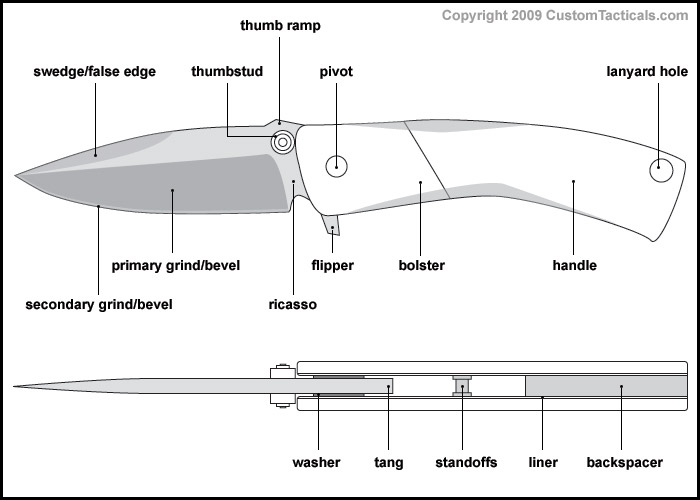Anatomy of a Folder/Folding Knife
Folding Knife Anatomy

Legend
Not all of these features will always be present on a folder, and conversely, there are features that some folders will have that are not illustrated here. The picture above is just one example of what a knife can have. There will be some useful information in the fixed blade anatomy page as well that will apply to both folders and fixed blades that is not included here as well.
Swedge/False Edge - This is a ground edge on the top (spine) side of the knife blade. The swedge is not usually sharpened, and is ground to aid in the penetrating ability of the tip and the overall balance of the knife. When the swedge is sharpened, it is no longer a swedge or false edge, but simply a top edge.
Thumbstud - The thumbstud is a protrustion from the side of the knife blade that allows the user to open the folder with his thumb. Sometimes the thumbstud appears in the form of a thumb disk or a hole in the blade. Funtionally these are more or less identical, allowing the user to open the knife with one hand. In the case of thumbstud, they often have the dual duty of acting as a stop pin for the blade as well.
Thumb Ramp - This is an angled ridge on the spine of the blade often with filework on it in order to give your thumb some traction when making a cut. The thumb ramp is very useful for making push cuts because you will gain some added leverage.
Pivot - This is where the pivot screw is placed and your knife blade pivots in and out of the handle. The pivot screw can usually be adjusted in order to improve the smoothness of opening the knife.
Lanyard Hole - A hole in the back of the handle to allow the attachment of a lanyard.
Secondary Grind/Bevel - This is the edge bevel which forms the final edge of the blade when it is present. Not all blade will have a secondary bevel. Some examples that do not have a secondary bevel are Scandinavian knives and Japanese Swords. The smaller this edge bevel is, the thinner the primary grind is, which can be an indicator of how 'sharp' a knife is.
Primary Grind/Bevel - All knives have a primary grind and this forms the majority of the edge grind of a knife. Many new tactical knives have very complex edge grinds that involve two or more primary grinds such as Strider's Nightmare Grind.
Ricasso - The ricasso is the unbevelled portion of the blade after the blade grind where the blade meets the handle. Usually a maker's mark can be found here.
Flipper - The flipper is a 'trigger' for flipping a knife open. In the closed position, the flipper appears as a protrustion from the back of the handle where it can be pushed, causing the knife to open.
Bolster - A portion of the handle that surrounds the pivot area. Traditionally the bolster was made of metal to 'bolster' the pivot, or give it strength. Now the pivot may be found in many different types of materials as modern composites have become extremely strong.
Handle - The handle is pretty self-explanatory, but consists of the largest part of the handle, separate from the bolster. When I refer to 'handle material', this is the portion that I am talking about.
Washer - Though not always present, most folders to have washers that may be made from bronze phosphorus, teflon or nylatron. Typically the thinner the washer, the more precise or difficult the construction of the folder.
Tang - On a folder, the tang is the portion of the blade that is hidden from view between the handle slabs.
Standoffs - Standoffs are primarly found on tactical folders and allow the knife to have an open design that is easier to clean while holding the knife handles together. They are generally cheaper to make than backspacers, and offer slightly less comfort when using the knife. Knives are not usually seen with both backspacers and standoffs as I have pictured here.
Liner - The liner is a thin peice of metal, usually steel or titanium, that is found under the handle slabs. It serves as reinforcement of the handle and is also where the lock on a liner lock knife comes from.
Backspacer - The backspacer holds the two sides of the knife handle together. On high-end folders it is often filworked and inlaid.